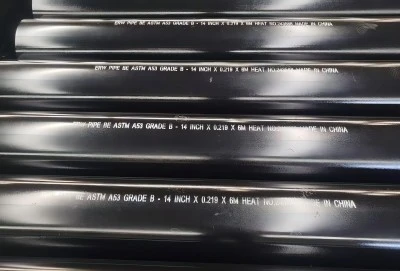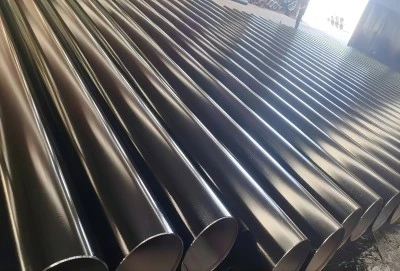Inspecting ERW steel pipes before installation is crucial for ensuring the integrity and longevity of your pipeline system. ERW (Electric Resistance Welded) pipes are widely used in oil and gas transportation, water supply systems, and industrial manufacturing due to their strength and cost-effectiveness. A thorough inspection process involves visual examination, non-destructive testing, and defect detection. By following these inspection techniques, you can identify potential issues early, prevent costly repairs, and maintain the safety and efficiency of your pipeline infrastructure.
|
|
|
Visual Inspection Techniques for ERW Pipes
Examining ERW Pipe Surface for Defects and AnomaliesVisual inspection is the first line of defense in assessing ERW steel pipe quality. Start by examining the entire surface of the pipe for any visible defects or anomalies. Look for signs of mechanical damage, such as dents, gouges, or scratches that could compromise the pipe's structural integrity. Pay close attention to the pipe ends, as they are particularly susceptible to damage during transportation and handling.
Check for uniform coloration and finish across the pipe surface. Any discoloration or inconsistencies may indicate potential issues with the manufacturing process or surface treatment. Inspect for signs of rust or corrosion, especially in areas where moisture might have accumulated during storage or transport.
Assessing Weld Seam Quality in ERW Steel Pipes
The weld seam is a critical area in ERW pipes and requires careful examination. Look for a continuous, straight weld line without any gaps, overlaps, or misalignments. The weld should be flush with the pipe surface and free from excessive reinforcement or undercutting. Any irregularities in the weld seam could lead to potential weak points in the pipe structure.
Use a magnifying glass or inspection mirror to closely examine the weld area for any cracks, pinholes, or porosity. These defects can significantly impact the pipe's performance and durability. Also, check for any signs of heat-affected zone (HAZ) discoloration, which may indicate improper welding temperatures or cooling rates.
Measuring ERW Pipe Dimensions and Tolerances
Accurate dimensions are crucial for proper pipe installation and system performance. Use calibrated measuring tools to verify the pipe's outside diameter, wall thickness, and length. Compare these measurements against the specified tolerances provided in relevant standards such as API 5L or ASTM A53.
Check for ovality by measuring the pipe diameter at different points along its length and circumference. Excessive ovality can lead to fitting issues and stress concentrations. Measure the straightness of the pipe by rolling it on a flat surface or using a straight edge along its length. Any significant deviations from straightness should be noted and evaluated for acceptability.
Non-Destructive Testing Methods for ERW Pipes
Ultrasonic Testing for ERW Pipe Integrity EvaluationUltrasonic testing (UT) is a powerful non-destructive method for evaluating ERW steel pipe integrity. This technique uses high-frequency sound waves to detect internal defects, measure wall thickness, and assess the quality of the weld seam. UT can identify hidden flaws such as laminations, inclusions, and lack of fusion in the weld area that may not be visible during visual inspection.
For ERW pipes, automated ultrasonic testing systems are often employed to scan the entire pipe circumference rapidly. These systems use multiple transducers to provide comprehensive coverage and can detect both longitudinal and transverse defects. The results are typically displayed as a color-coded map, allowing inspectors to quickly identify and locate potential issues.
Magnetic Particle Inspection of ERW Pipe Welds
Magnetic Particle Inspection (MPI) is particularly effective for detecting surface and near-surface defects in ferromagnetic materials like ERW steel pipes. This method involves magnetizing the pipe and applying magnetic particles to the surface. Any discontinuities in the material, such as cracks or seams, will cause a distortion in the magnetic field, attracting the particles and revealing the defect location.
MPI is especially useful for inspecting the weld seam area of ERW pipes. It can detect fine cracks, lack of fusion, and other weld-related defects that may be missed during visual inspection. When performing MPI, ensure proper magnetization techniques are used to cover all orientations of potential defects.
Eddy Current Testing for ERW Pipe Defect Detection
Eddy Current Testing (ECT) is a versatile non-destructive method that can detect surface and near-surface defects in ERW pipes. This technique induces electromagnetic fields in the pipe material and analyzes the changes in these fields to identify anomalies. ECT is particularly effective for detecting cracks, pits, and other surface imperfections.
In ERW steel pipe inspection, ECT can be used to scan the entire pipe length quickly, making it ideal for high-volume production environments. It's especially useful for detecting longitudinal defects along the weld seam. Advanced ECT systems can provide real-time data and imaging, allowing for immediate identification and marking of defective areas.
Common Defects in ERW Pipes: Detection Guide
Identifying Weld Line Defects in ERW Steel PipesWeld line defects are among the most critical issues to address in ERW steel pipes. Common weld-related problems include lack of fusion, cold laps, and hook cracks. Lack of fusion occurs when the edges of the pipe don't fully melt and join during the welding process, creating a weak point in the pipe structure. Cold laps are similar but involve a folding over of the material at the weld edge.
Hook cracks are small, curved cracks that can form at the edge of the weld seam due to improper welding parameters or material issues. These defects may not be immediately visible and often require non-destructive testing methods like ultrasonic or eddy current testing for detection. Regular calibration and maintenance of welding equipment can help prevent many of these issues.
Detecting Laminations and Inclusions in ERW Pipe Walls
Laminations are internal separations or weaknesses in the pipe wall that run parallel to the surface. They can occur due to defects in the steel sheet used to manufacture the pipe or from improper rolling processes. Inclusions are foreign particles trapped within the steel during its production, which can create weak points in the pipe structure.
Ultrasonic testing is the primary method for detecting laminations and inclusions in ERW steel pipes. Advanced UT techniques, such as phased array ultrasonic testing (PAUT), can provide detailed imaging of these internal defects. Regular quality checks of raw materials and strict control of the pipe manufacturing process are essential in minimizing the occurrence of these defects.
Recognizing Corrosion and Pitting in ERW Pipe Surfaces
Corrosion and pitting can significantly reduce the service life of ERW steel pipes. External corrosion may occur due to environmental factors or inadequate protective coatings, while internal corrosion can result from the transported fluids or gases. Pitting is a localized form of corrosion that creates small holes or cavities in the pipe surface.
Visual inspection is the first step in identifying surface corrosion and pitting. Use strong lighting and, if necessary, magnification to examine the pipe surface thoroughly. For more detailed analysis, ultrasonic thickness measurements can track wall thinning due to corrosion. In cases where internal corrosion is suspected, remote visual inspection tools or intelligent pigging techniques may be necessary.
Thorough inspection of ERW pipes before installation is essential for ensuring the reliability and longevity of pipeline systems. By combining visual inspection techniques with advanced non-destructive testing methods, you can effectively identify and address potential defects. Regular quality checks, adherence to industry standards, and proper handling practices are key to maintaining the integrity of ERW steel pipes. Remember, early detection of issues can prevent costly failures and ensure the safe operation of your pipeline infrastructure.
ERW Pipes Manufacturer
When sourcing high-quality ERW steel pipes for your projects, consider Hebei Longma Group, a leading manufacturer with advanced production capabilities. Our state-of-the-art equipment, imported from Germany and complemented by our own innovations, ensures superior product quality. With a professional team of over 300 employees, including 60+ technical experts, we guarantee expertise in every aspect of ERW pipe production.
Our comprehensive testing facilities, featuring online ultrasonic automatic flaw detectors and industrial X-ray television, ensure rigorous quality control. We offer fast delivery, with standard thickness pipes ready in as little as 7 days. Hebei Longma Group holds all necessary certifications, including API 5L, ISO 9001, ISO 14001, and FPC, demonstrating our commitment to quality and environmental standards. Our competitive pricing is achieved through long-term partnerships with raw material suppliers and an integrated production model. For reliable ERW pipes that meet your project requirements, contact us at info@longma-group.com.














